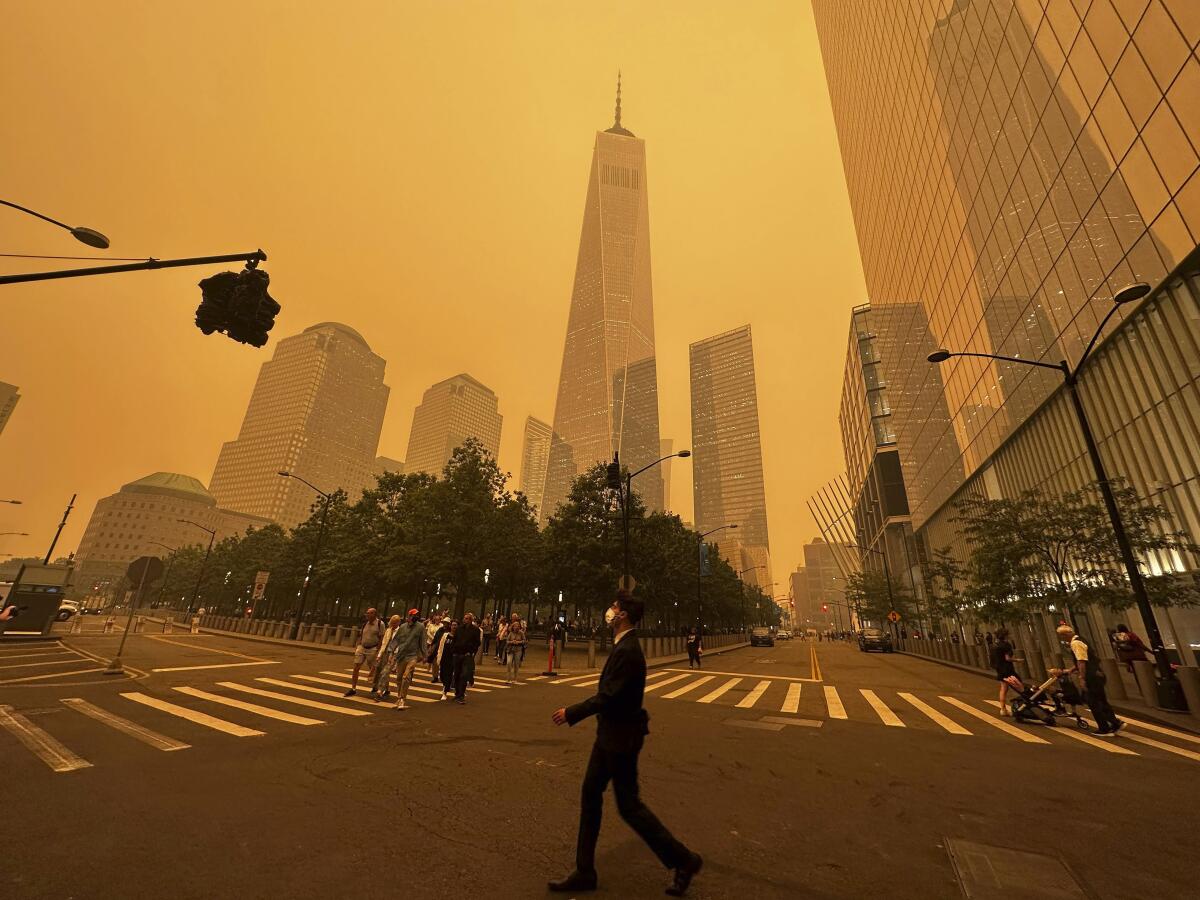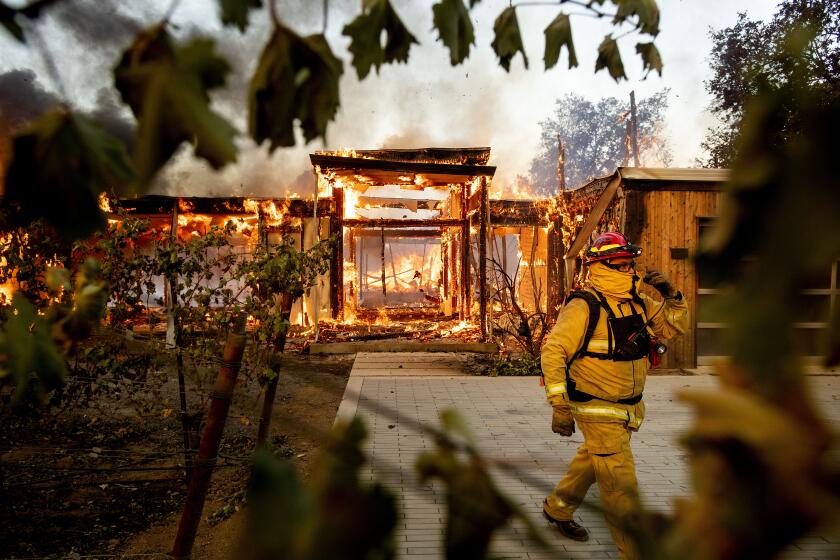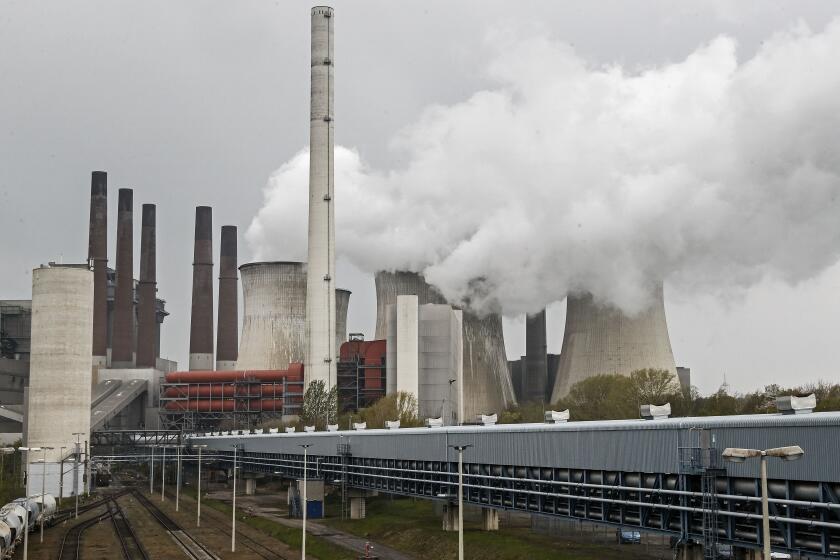Editorial: Orange skies in New York? Welcome to our smoke-filled, climate-fueled future

- Share via
The choking siege of smoke over much of the Eastern U.S. from wildfires in Canada has exposed millions of Americans to dangerous levels of lung-damaging pollution. Wednesday was by far the nation’s worst day in recent history for wildfire smoke pollution, with more people exposed to higher levels of soot than any day since 2006, according to a rapid analysis by Stanford University scientists.
That’s hardly a surprise to people from New York to Minnesota who have been suffering under this acrid, life-threatening pall. And it’s the type of in-your-face environmental health crisis that Californians know too well, with authorities urging people to stay inside and filter the air they breathe and canceling outdoor activities, and large numbers of people almost certainly getting sick or dying. The second-worst smoke day, after all, was in September 2020, when the haze from an explosion of climate-fueled wildfires up and down the West Coast blotted out the sun, shrouding San Francisco in an apocalyptic orange and contributing to potentially thousands of early deaths.
The otherworldly veil that has hung over some of the nation’s most densely populated areas is the latest illustration of the fact that an overheating planet knows no human-made boundaries, and that as much as we try, no one will be spared the impacts. Everyone, after all, has to breathe.
State Farm said it will stop writing new home insurance policies because of climate risks and rising costs. California lawmakers need to be more aggressive in building safer communities.
These wildfire smoke episodes are disasters as serious as hurricanes, floods or heat waves, and come with a steep human toll. Whether in the East or in the West, they are just one tragic example of how climate change is coming for us all in both a slow accretion and sudden, dramatic bursts.
We often talk about global warming in terms of incremental change, like fractions of degrees over decades. But it also moves quickly, through the amplification of extreme events such as California’s recent spate of record-breaking wildfires, the deadly 2021 Pacific Northwest “heat dome” that pushed temperatures in Portland, Ore., to an unthinkable 116 degrees and the torrential rain of Hurricane Harvey in 2017 that flooded tens of thousands of homes in Texas and Louisiana. Now we add to this horrible list the Manhattan skyline enveloped in a sickly sepia smog that looks as if it floated out of the dystopian world of “Blade Runner 2049.”
These smoke-filled vistas should be front of mind when we talk about the climate crisis, because they send a clear signal that it’s a health crisis too.
U.N. climate report shows we can’t just phase out oil and gas; we have to deliberately dismantle existing infrastructure, such as coal plants in China and drilling in Alaska.
And unfortunately, many Americans can expect more smoky days like these in their future. Much like heat waves, “smoke waves,” a term researchers coined several years ago to describe consecutive days of unhealthy air quality from wildfires, are expected to grow more frequent, long-lasting and intense over the next few decades. Growing numbers of people will have to contend with unhealthy levels of smoke, a particularly nasty type of pollution that lodges deep in the lungs and can enter the bloodstream to worsen asthma, lung and heart disease and cut lives short.
The increase in smoke pollution, driven by bigger, more intense fires fueled by human-caused global warming, has already been eroding hard-won improvements in the nation’s air quality from decades of emissions-cutting regulations. And even people living hundreds of miles from a wildfire can pay a grave health toll. One 2021 study found that about three-quarters of the wildfire smoke-related asthma emergency room visits and deaths in recent years occurred east of the Rocky Mountains, due to the region’s higher population density.
We have a chance to reduce this suffering, and prevent an even worse lung-choking reality for future generations. But only if we use this as an inflection point to get serious about slashing climate pollution and putting an end to the extraction and burning of fossil fuels. Let’s not wait until the smoke clears to start.
More to Read
A cure for the common opinion
Get thought-provoking perspectives with our weekly newsletter.
You may occasionally receive promotional content from the Los Angeles Times.












